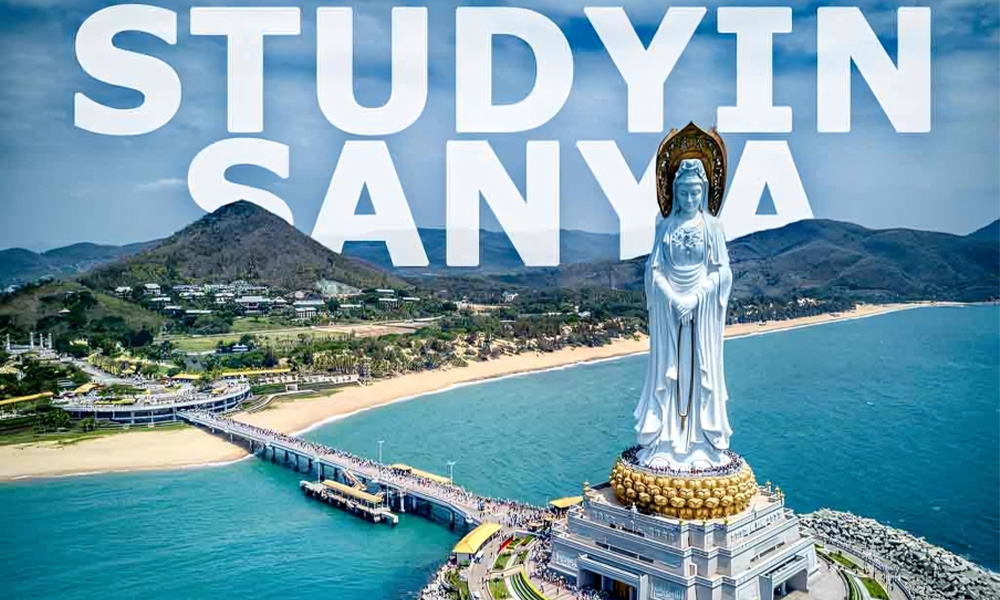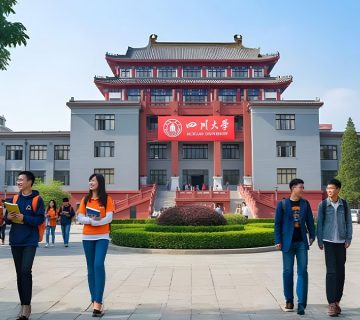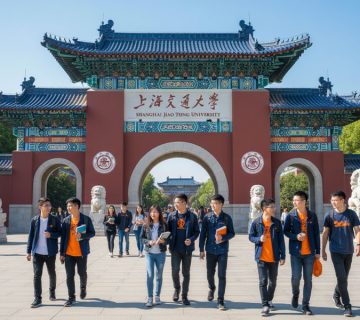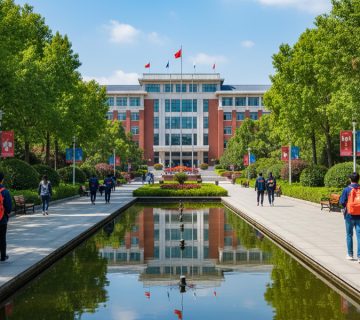Sanya, at the tip of Hainan Island, is the sea’s sirenic beckoning—white shores stretching endlessly, blue waves crashing onto volcanic coastlines, and a year-round blanket of sunlight that feels like nature’s welcome mat. Dubbed the “Hawaii of China,” this seaside gem is not merely a tourist postcard brochure but is increasingly becoming a whirlpool of academic fervor, wherein the rustling of palm fronds is in harmony with the rhythm of learned ambitions.
As we head into 2025, study in Sanya universities is not just books and classrooms—it’s the chance to weave your future amidst coral reefs and cultural intersections, aided by access to China’s booming tropical economy. In this guide from admission institute, we’ll chip away at the admission requirements for Sanya universities—spotlighting best institutions, and analyzing tuition fees of Sanya universities alongside day-to-day living expenses.
About Sanya
Sanya’s universities are not remnants of bygone academe; they are dynamic hubs fueled by Hainan’s Free Trade Port ambitions, blending native Li and Miao culture with international partnerships. For overseas students seeking a fresh start, the allure is clear: affordable adventures in one of Asia’s most livable destinations. But what attracts visionaries to these shores?
It’s the union of cutting-edge facilities, specialty programs that match the blue-green economy of the island, and a living cost that lets you treat yourself to fresh coconut water without breaking your bank. Whether you’re a high school diploma recipient studying for a bachelor’s degree in hospitality or an in-career professional seeking a master’s degree in ocean tech, study in Sanya universities promise growth as expansive as the South China Sea.

Why Sanya? A Tropical Twist on Chinese Higher Ed
Sanya’s educational past starts with its geography—a subtropical haven in which typhoons are unknown, and nature’s preservation is paramount. But Hainan’s 2018 switch to a free trade port was what gave the scene it turbocharges, pumping billions of dollars into infrastructure and attracting overseas talent.
1. Education, cultural immersion and diversity
Schools here are not just teaching; they’re partnering with giants such as the Chinese Academy of Sciences on deep-sea research or Geely Group on automotive innovation. The result? Tailor-made courses for the jobs of tomorrow in tourism, biotech, and renewable energy. For international students, the appeal goes even further. Over 5,000 foreign students flocked to Hainan schools last year, drawn by scholarships covering 100% of tuition and a visa process as smooth as a catamaran ride on the ocean.
English-medium courses are on the rise, and cultural immersion? Picture racing a dragon boat, or learning Hainanese opera—excursions that linger longer than any page in a textbook. And with non-stop flights from over 50 cities around the world, getting there is as easy as booking a beach read. But it is the personal touch that makes Sanya truly shine. Campuses buzz with diversity: Africans, scheming fintech start-ups, Europeans, tagging sea turtles with satellite transmitters, and Southeast Asians, playing with batik and digital art.
In a pandemic world starved for contact, such universities form communities where borders dissolve faster than salt on ocean water. As one of the Indonesian graduates testified on the platform of Hainan Tropical Ocean University, “Sanya did not only teach me ecology; it taught me to think of the world as one big reef—interconnected and robust.”
2. Economic Opportunities
Economically, the timing could not be any better for 2025 intakes. The GDP growth of Hainan was a peak 10.7% last year, above the national average, with Sanya leading the way for luxury resorts and yacht marinas. Graduates go on to work in companies like Atlantis Sanya or the Boao Forum, merging academic qualifications and island expertise. When thinking of studying at Sanya universities, think of it as an investment in a degree that is as sellable as it is unforgettable.

Top universities of Sanya 2025
Three pillars fuel this education renaissance: Hainan Tropical Ocean University (HTOU), Sanya University (SYU), and the University of Sanya (USY). Each fills a distinctive niche, from ocean-emphasizing undergrads to industry-linked grad programs. Meet them.
1. Hainan Tropical Ocean University (HTOU): Waves of Innovation
Perched on Sanya’s eastern promontory, HTOU has its roots in 1954 as a fishery school that grew into a ministry-China oil corporation-sponsored provincial behemoth. It encompasses 13 schools and 39 undergraduate courses and has more than 20,000 students, including a burgeoning group of internationals. Official statistics from htour.edu.cn spotlight its edge in maritime sciences—picture labs spreading out coral genomes or boats tracing monsoon currents.
HTOU thrives for experiential learners who like to study in Sanya universities. Its 171,400 square meters of instructional space include nine experiment centers, from aqua tanks housing tropical fish to simulated typhoon bays. Specializations like Marine Technology or Tourism Management are not abstract; they’re in action at nearby Yanoda Rainforest or the Sanya Coral Reef National Nature Reserve. International student registration has increased 15% annually, with ASEAN partnerships facilitating credit transfers.
Why HTOU?
It is the sole state-owned uni in Sanya, blending public discipline with private nimbleness. Alumni networks stretch from Beijing policy halls to Dubai dive ops, with 96% employment for Hainan graduates. In 2025, expect new majors in blue carbon economics, in keeping with China’s carbon neutrality pledge. If your hearts at the point where land and sea converge to study in Sanya universities, HTOU is your anchor.
2. Sanya University (SYU): International Giant in the Making
Just across the street from HTOU, SYU, which was once Sanya College, prospered under Geely Holding Group’s wing since 2005. Hainan’s largest private undergraduate university, it boasts 20,000-25,000 students studying in 63 majors as per its 4icu.org ranking. Its campus sprawls across 3,000 acres, its state-of-the-art library housing 2 million books and its laboratories buzzing with AI-facilitated tourism simulations. SYU’s magic formula? Convergence of the sectors. It’s built Hainan’s first Fashion and Health Industry School, in partnership with the National Development and Reform Commission for health-related studies. Cruise Operations or Golf Management aren’t frills—they’re doors to Ritz-Carlton resort or Viking Cruises employment. Global linkages? Over 30 linkages, including Silk Road Business School seminars that bring in ASEAN deans.
Internationals are drawn to SYU because it boasts the employability crown: six years running as Hainan’s top private uni for graduate employment, hitting 96% levels. In 2018, it was ranked “six-star” by Chinese Alumni Network, rubbing shoulders with the likes of Fudan. 2025 is the year for health tourism expansions, capitalizing on the spa boom in Sanya. If you crave a degree as a career springboard, SYU has it.

3. University of Sanya (USY): Corporate Edge and Creative Currents
Geely’s second brain, USY (customarily listed synonymously with SYU but obviously branded separately), concentrates on applied arts and technology. USY is one of the best options to study in Sanya universities. conceived alongside SYU, it shares the same address at 191 Xueyuan Road but leaves an imprint by way of design and innovation. Official photos at sanyau.edu.cn present micro-landscape art exhibitions during Boao Forum—bonsai seascapes standing in for Hainan’s story, as such.
With 18 colleges and a faculty of 1,000+, USY enrolls 20,000+, with emphasis on 63 undergraduate tracks. MVPs are Animation or International Trade, with Geely internships in electric cars. Its Public Diplomacy Center, backed by former foreign ministers, trains global communicators. USY’s culture? Entrepreneurial. Student enterprises pitch at Microsoft Hainan centers, and Cornerstone Plan subsidizes “thousand-talents” young people. Internationals receive access to forums like China-ASEAN Education Co-op. 2025 shines a spotlight on sustainable design, complementing Sanya’s green resort drive. Creative minds, this is your palette.
These unis aren’t rivals; they’re complements, part of Sanya’s island nation of learning. Together, they provide 150+ programs, ranging from HSK-prep language majors to PhDs in tropical ag.
Admission Requirements for Sanya Universities
Admission requirements for Sanya universities are easy but takes preparation—like Reef-Safe sunscreen. All follow China’s national standards via CUCAS or direct sites, stressing health, studies, and cultural harmony. Let’s explain the admission requirements for study in Sanya universities.
1. HTOU
At HTOU, undergraduate applicants need high school diplomas (or equivalent), aged 18-25 years, nonchains nationals in good health. Language? HSK 4 for Chinese-language majors; IELTS 6.0 or TOEFL 80 for English-language ones like Marine Biology. Apply through htour.edu.cn: passport photocopies, transcripts (notarized), physical examination (Form 0840), and an app fee of 400 RMB. Deadlines? March 15 for fall semester (September intake), November 15 for spring semester. Interviews pose motivational questions—be ready to be asked why oceans matter. Postgrads raise the stakes: bachelor’s degree for master’s, GPA 3.0 and above, HSK 5/6. PhDs require publications. What gives HTOU an edge? ASEAN quotas facilitate Southeast Asians’ entry.
2. SYU
SYU replicates this but leans flexible for privates. High school graduates, ages 18-30, apply online at sanyau.edu.cn, with attached diplomas, letters of recommendation, and study plans (500 words). No entrance exam; meritorious based on documents. English majors (Hotel Management, etc.) prefer TOEFL 79; Chinese, HSK 4. Fee: 300 RMB. May 31 deadline for fall. SYU scouts’ talent at Silk Road fairs—network there. USY is the same as SYU, emphasis on arts track portfolios. Add a creative statement; Zoom interviews assess passion.
Similarities: JW202 application form for X1/X2 visas, insurance mandatory (800 RMB/year). Rejection? Typically, docs—get them notarized and translated. Tip: Start six months ahead; Hainan’s consulates are efficient but off-season lines form.
Success stories abound. One Kenyan at HTOU gained admission on an essay about coral conservation; now he’s surveying reefs. Personalize yours—describe how Sanya’s oceans stir your soul.

Sanya University Tuition Fees: Value in Every Credit
Money speaks, but tuition fees of Sanya universities carry more force than weight—global quality at domestic prices. Average costs of study in Sanya universities are 18,000-25,000 RMB/year for undergraduates by CUCAS estimates, significantly lower than study in Beijing universities 30,000+.
HTOU affordability bests: 15,000-20,000 RMB for most bachelors (e.g., Aquaculture: 16,000). English streams +2,000; postgrads +22,000-28,000. Oceanography Master’s? 24,000. Hidden gems: lab fees (500 RMB/semester), but dorms level at 2,000-4,000/year (double rooms with AC, sea view).
SYU private polish rates 20,000-28,000 RMB—Hospitality: 22,000; Fashion Design: 25,000. English Cruise Management: 26,000. Perks? Geely stipends cut 20% for highest admits. Books: 800 RMB/year; insurance packaged.
USY matches: 21,000-27,000 RMB, with Animation at 24,000. Joint programs (e.g., with UK unis) up to 30,000 but lead to dual degrees.
Scholarships make it even sweeter. CSC covers full tuition + 3,500 RMB/month stipend for 279 unis, including these. Hainan Provincial: 10,000-40,000 RMB/year for ASEAN children. SYU’s Silk Road: full scholarship + internship. Apply through CSC portal by April; unis nominate.
Net? A four-year bachelor’s costs 80,000-100,000 RMB—less than $14,000 USD—versus $200,000+ on one’s own side.
Costs of study in Sanya universities VS Beijing
| Category | Sanya (Hainan university/Sanya university | Beijing (Peking university/ Tsinghua university | Notes |
| Undergraduate Tuition (RMB/Year) | 15.000-28.000 | 26.000-450.000 | Based in official university sites via CUVAS; English taught programs; exclude lab fees |
| Accommodation (RMB/Year) | 2.000-4.800 (campus dorms, double room with AD; avg) | 7.200-12.000(international dorms, single/double; avg) | Sanya: sea view options; Beijing: city center proximity; |
| Living Expenses (RMB/Month) | 4.000-6.000 (total incl. food 800-1.200, transport 100-200) | 6.000-9.000 (Total incl. food 1.500-2.500, transport 225) | Sanya cheaper due to tropical produce/seafood; Beijing higher for urban dining/transport. |
| Insurance (RMB/year) | 800 (mandatory student plan) | 800 (mandatory student plan) | Standard across China; covers basic medical. |
| Application fee (one time /RMB) | 300-400 | 600-800 | Non-refundable; via CUCAS or direct portals. |
| Total Estimated Annual Cost (RMB) | 35.000-50.000 (tuition, accommodation, living, insurance) | 60.000-85.000 (tuition, accommodation, living, insurance) | Exclude books (1.000 RMB/Year) and visa (500 RMB); scholarships can reduce by 50-100% in both. |
Comparison of Tuition and Living Costs: Sanya vs Beijing Universities (2025)Nubmeo.com (updated 10/18/2025)

Sanya Beyond Books: Experiencing the Sanya Student Life
Sanya’s beauty extends beyond campus. Monthly living? 4,000-6,000 RMB, based on Numbeo/Livingcost.org data updates for 2025. Breakdown:
- Dorms/Off-Campus: Double rooms provided by unis 200-400 RMB/month; private studio apartments 1,500-2,500 in beach areas.
- Eats: Campus canteen meals: 10-15 RMB/meals (Hainanese rice noodles, seafood stir-fry). Off-campus: 20-50 RMB. Groceries: 800-1,200 RMB (mangoes 5 RMB/kg, street skewers 2 RMB).
- Commute: Buses 2 RMB/ride; bike-shares 1 RMB/hour. Taxis: 10-20 RMB short distances.
- Fun & Fit: Gym 100 RMB/month; beaches are free. Night markets: 50 RMB treat. Health: Clinics 50 RMB/visit.
Student overall budget: 5,000 RMB/month, leaving room for surf lessons (200 RMB/session). Sustainable? Absolutely—recycle for deals, take up environmental clubs.
Conclusion
As sunset seeps over Yalong Bay, painting Sanya’s skyline golden, it’s clear: sturdy in Sanya universities is not a detour—it’s the scenic route to a bolder you. From HTOU’s salty laboratories to SYU’s stylish studios, these campuses offer admission requirements for Sanya universities that respect preparation, and tuition fees of Sanya universities that respect your wallet. Scholarships abound, living costs entice, and chances? As endless as the horizon.
In 2025, in the trade winds of change in Hainan, take this. Apply now—your reef is waiting. Whether charting currents or creating campaigns, Sanya prepares you to ride the tides of life. Come on in; the water’s fine. Contact us if you are interested in study in one of the best Chinese cities.
FAQ:
1. What are the most important admission requirements of Sanya universities in 2025?
For HTOU, SYU, and USY undergraduate programs, you will need a high school diploma, HSK 4 (Chinese-medium) or IELTS 6.0/TOEFL 80 (English-medium), passport, transcript, and physical exam form. Apply online during March to May with a 300-400 RMB fee—no entrance exam. Postgrads need bachelor’s and HSK 5+. ASEAN students are offered priority quotas. Prepare six months earlier for expedited JW202 visa processing.
2. How much are Sanya university tuition fees, and are there any scholarships?
Undergraduate tuition 15,000-28,000 RMB/year: HTOU (16,000 for Aquaculture), SYU (22,000 for Hospitality), USY (24,000 for Animation). Masters: 22,000-28,000 RMB. CSC scholarships cover full tuition + 3,500 RMB/month stipend; Hainan Provincial provides 10,000-40,000 RMB for ASEAN nationals. Apply at csc.edu.cn by April—more than 70% of internationals qualify!
3. How expensive is it to live like a student in Sanya monthly?
Budget 4,000-6,000 RMB: dorms (200-400 RMB), food (10-15 RMB in canteens), transportation (2 RMB bus), food shopping (800 RMB). Add 100 RMB gym and free beaches. Leaves less than 5,000 RMB for surf lessons (200 RMB). It’s 60% cheaper than Shanghai, per Numbeo 2025 figures—perfect for living on scholarships!





No comment